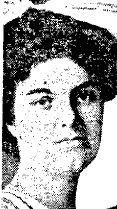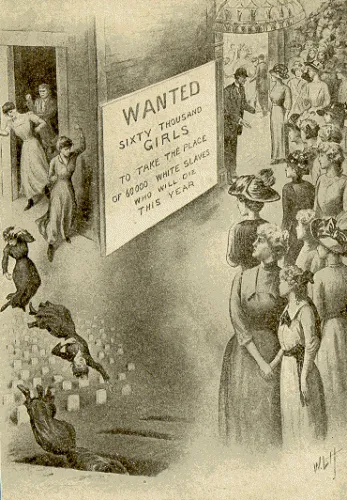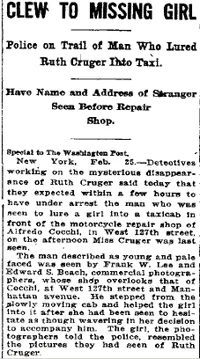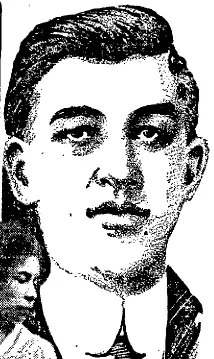“Mrs. Sherlock Holmes” Takes on the NYPD
When an 18-year-old girl went missing, the police let the case grow cold. But Grace Humiston, a soft-spoken private investigator, wouldn’t let it lie
/https://tf-cmsv2-smithsonianmag-media.s3.amazonaws.com/filer/20110823105012small-Grace-Humiston-line-drawing-New-York-Times-June-24-1917.jpg)
Unlike in Mike Dash’s recent tale of a mysterious cold case, detectives knew right away the identity of a body found in Harlem on a cloudy spring day in June 1917. She was 18-year-old Ruth Cruger, who had been missing since February 13. She’d left her home on Claremont Avenue that morning wearing a blue velvet coat, a black hat adorned with a flowered ribbon, white kid gloves and her new graduation ring from Wadleigh High School. She walked toward 127th Street with a pair of ice skates dangling from her wrist and was never seen again.
The morning after Ruth disappeared, her older sister, Helen, searched for clues in their neighborhood. She recalled Ruth mentioning a motorcycle shop a few blocks away where she could get her skates sharpened. Helen arrived at the store around 9:30 and found it closed. She returned an hour later and this time the front door was padlocked. Finally, at 2:30 p.m., the shop was open. Inside she found several women waiting to have baby carriages repaired and a man hunched over a bicycle.
“Did my sister leave her skates to be sharpened yesterday?” Helen asked.
The man replied that a young woman had left a pair of skates to be sharpened in the morning and returned for them later.
“What kind of skates were they?”
“They were fastened on shoes like you have on,” the man answered.
“Was she a dark and attractive girl?” Helen asked.
“Yes.”

Helen rushed home to recount the encounter to her father, Henry. He called the police and spoke with a detective, who reasoned that the shop’s owner, Alfredo Cocchi, had initially been absent from his counter because he had repair jobs in the neighborhood. The detective insisted that the Cocchi was a “respectable businessman” but agreed to pay him a visit, and afterward wrote a report that consisted solely of the line, “I searched the cellar.”
The New York Police Department seemed content to let the case grow cold, but Ruth Cruger quickly became a national fixation. The victim’s profile—young, white, attractive, from a respectable family—revived interest in “white slavery,” the idea that the thousands of girls who vanished every year in New York and other large cities had, one way or another, entered the “sporting life,” or prostitution. After a sensational 1907 case in Chicago, a frenzy over white slavery erupted; Americans lived in a state of fear equivalent to the atomic bomb scares of the 1950s or the early post-9/11 terror alerts. Newspapers printed daily “agony columns” listing the names of missing girls, and Progressive Era reformers crafted lurid narratives to rouse the public’s interest, books with titles like The Black Traffic in White Girls that read like porn for puritans.

Most reformers harbored nativist sentiment and warned that the large influx of immigrants, particularly those from Southern and Eastern Europe, were changing the character of the country. They argued that such men—mainly Greeks, Italians and Jews—acted as “panders” in the red-light districts, organizing the kidnapping, rape and sale of young girls to enterprising madams. The white slavery phenomenon peaked in June 1910, when Congress passed, and President William Howard Taft signed, the White Slave Traffic Act—better known as the Mann Act after its author, Congressman James Robert Mann. The Mann Act forbade the interstate transport of women for “immoral purposes” without specifying the exact meaning of the phrase (which ultimately allowed the government to investigate anyone it found objectionable for any reason, including Frank Lloyd Wright, Charlie Chaplin and Jack Johnson).
The advance of the automobile changed the business of prostitution. More “sporting girls” made house calls, and red-light districts across the country began to shut down. Public opinion shifted as well; prostitutes were no longer considered victims, but simple-minded girls of questionable character and dubious acquaintance. The New York Police Department suggested that Ruth Cruger fit this profile, saying she “wants to be lost” and presenting scenarios that might explain her motive for running away. One witness spotted a girl matching Ruth’s description climbing into a taxicab with an unidentified man; another suspect, whose name was never released, was believed to have “met Miss Cruger several times without the knowledge of her parents.”

Meanwhile, Alfredo Cocchi fled back to his native Italy—an escape the Cruger family suspected was aided by police. Exasperated, Henry Cruger posted a $1,000 reward for information about the case and hired an lawyer-turned-investigator named Grace Humiston, who had gained notoriety the previous year by battling to save the life of a man on Sing Sing’s death row. (She would eventually prove he had been convicted on falsified evidence and secure his release). Before that, she had gone under cover and infiltrated turpentine camps in the South, where she discovered entire families working under slave labor conditions.
At age 46, with black hair coiled in a bun and a tendency to speak sotto voce, Humiston seemed more like a librarian than a crusader for justice. When a reporter for the New York Times visited her office at Madison Avenue and 42nd Street, she was on the phone with her mother, asking her to water her plants. “It was like dropping in at Baker Street and having Holmes throw the pipe, the violin and the hypodermic out of the window and begin to discuss how many strawberries make a shortcake,” the reporter noted. “Frankly, so far as appearances go, Ms. Humiston is badly miscast in the role of sleuth extraordinary, or as the program might say—‘Mrs. Sherlock Holmes.’”
Humiston spent 15 hours a day on the case, working pro bono, interviewing Harlem residents who might have noticed suspicious activity around Cocchi’s shop. One man recalled seeing Cocchi emerge from his basement around midnight on February 13, covered with dirt and appearing “nervous.” Another spotted Cocchi the following night, again “dirty and nervous.” On this evidence, Humiston went to Cocchi’s shop, determined to get into the cellar.
Cocchi’s wife appeared at the door wielding a brick. “I’ll split your skull with this brick if you try to come in here,” she said.
Humiston reported the threat to Police Commissioner Arthur Woods, who granted her a search permit. On June 16, she enlisted the help of Patrick Solam, a close friend of the Cruger family and the general foreman for Grand Central Terminal. Solam started in the main basement room, directly beneath the shop. A cluster of benches, toolboxes and chests of drawers created a triangular work area. Solam noticed that one chest along the southeast corner of the room slanted slightly, protruding an inch beyond the others. He asked two assistants to help move it.
They discovered that the concrete floor beneath had been smashed with a hatchet or axe and then sliced with a saw. They took turns digging, removing layers of ashes, cinders, dirt and chips of broken concrete. Farther down, embedded in the dirt, they found a pair of dark trousers with pinstripes and stains, and beneath that a large sheet of rubber, carefully arranged to prevent any odor from rising to the surface.
Three feet down, the pit sloped to the west. A shovel struck something hard. Solam lowered himself into the hole and felt a sharp knob—the exposed hip of a body. They pulled the body up, inch by inch, and swept away the dirt. A piece of hemp rope nine feet long was knotted tightly around the ankles, cutting into the flesh. A towel looped around the neck. The feet bore shoes and stockings, both brown, and the blue of a velvet coat had faded to slate. Kid gloves still concealed the hands, and a black hat lay smashed deep inside the pit. The final discovery was a pair of ice skates, covered with mottled blood.

The victim’s skull had been crushed from behind, just above the left ear. Humiston confirmed that the clothes were those worn by Ruth Cruger the day she disappeared. She convinced Henry Cruger not to go into the basement, and he later identified his daughter by her graduation ring. An autopsy revealed a deep gash in Ruth’s abdomen extending to her spine, carved with the blade of her own skate—an injury that classified the case, in the parlance of the times, as a “ripper.” Otto H. Schultze, medical assistant to the district attorney, determined that the killer inflicted the wound after the blow that crushed Ruth’s skull but before her death.
Italian officials refused to extradite Alfredo Cocchi, but he was arrested in Bologna and confessed to the assault and murder of Ruth Cruger. “I had never seen Ruth Cruger before she came to my shop to have her skates sharpened,” he said. “From the very beginning Ruth did all in her power to attract my attention. I felt something strange when her dark, penetrating eyes fixed on mine. I was still more disconcerted when she came again to get her skates. An overpowering attraction for the young woman seized me. What happened afterward seems like a dream.” He was sentenced to 27 years in prison.
Humiston wasn’t finished. She publicly accused the NYPD of negligence, and a subsequent investigation by Police Commissioner Woods revealed a longstanding, mutually beneficial relationship between Cocchi and the department. If an officer arrested someone for speeding he would send the offender to Cocchi, suggesting that the repairman was able to compromise cases for a small fee. Cocchi would collect the fee, keep a portion for himself and kick back the rest to the officer.
Next she gave a series of interviews intended both to rehabilitate Ruth’s character and lay the groundwork for the next phase of her own career. “I started out with the conviction that Ruth Cruger was a good girl,” she said. “I knew that one of her training and character never would figure in an elopement or anything of that kind. Working on this conviction of mine, I knew that the police theory of ‘waywardness’ was all bosh.” She suggested that Cocchi had intended to force Cruger into prostitution and urged the city to renew its efforts against white slavery: “What I think is needed is a bureau that would prevent girls from getting into the hands of these beasts, rescue them if they were already snared, and then cure them of their moral ailment. Do you know that no girl of the streets, if rescued before she reaches the age of 25, ever continues her shameful trade?”
In July 1917, Humiston was named a special investigator to the New York City Police Department, charged with tracing missing girls and uncovering evidence of white slave traffic. At the same time she formed the Morality League of America—a throwback to the anti-vice organizations prevalent in the years leading to the passage of the Mann Act. Hundreds of families sought her help in locating their missing daughters and sisters. The Cruger murder brought Grace Humiston national renown, but she, along with scores of other prominent Progressive Era reformers, was eventually lost to history. Later newspaper recollections of the Cruger case fail to mention “Mrs. Sherlock Holmes” at all.
Sources
Books:
Clifford G. Roe. The Great War on White Slavery: Or, Fighting for the Protection of Our Girls. Philadelphia: P.W. Ziegler Co., 1911.
Karen Abbott. Sin in the Second City: Madams, Ministers, Playboys and the Battle for America’s Soul. New York: Random House, 2007.
Articles:
“Ruth Cruger’s Slayer Adds to His Confession.” San Francisco Chronicle, June 26, 1917; “Cocchi Will Fight Efforts to Bring Him Back.” The Hartford Courant, June 23, 1917; “Clew to Missing Girl.” The Washington Post, February 26, 1917; “Cocchi Confesses He Murdered Girl in Jealous Rage.” The Atlanta Constitution, June 24, 1917; “Cocchi Convicted, Gets 27 Years.” The New York Times, October 30, 1920; “Ruth Cruger’s Murder Called a ‘Ripper’ Case.” The Hartford Courant, June 18, 1917; “Cocchi Could Not Stand Ruth Cruger’s Dark Eyes.” Boston Daily Globe, June 26, 1917; “Slew Her With Skate.” The Washington Post, June 18, 1917. “Mrs. Humiston’s Theory Solves Cruger Mystery.” New York Tribune, June 17, 1917; “Mrs. Humiston, The Woman Who Shamed Police in the Ruth Cruger Murder Case.” The New York Times, June 24, 1917.
/https://tf-cmsv2-smithsonianmag-media.s3.amazonaws.com/accounts/headshot/karen-abbot-240.jpg)
/https://tf-cmsv2-smithsonianmag-media.s3.amazonaws.com/accounts/headshot/karen-abbot-240.jpg)